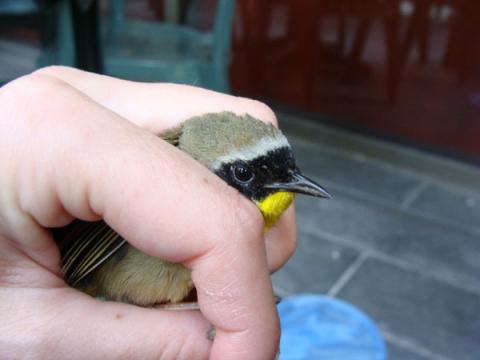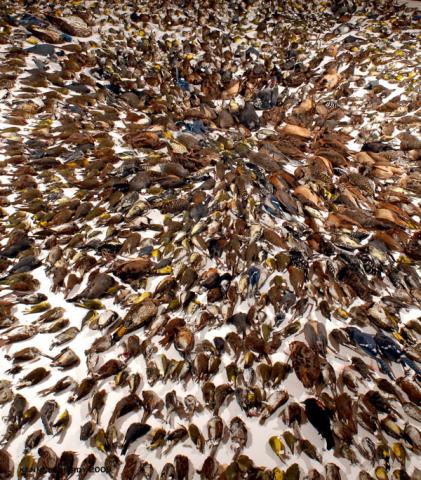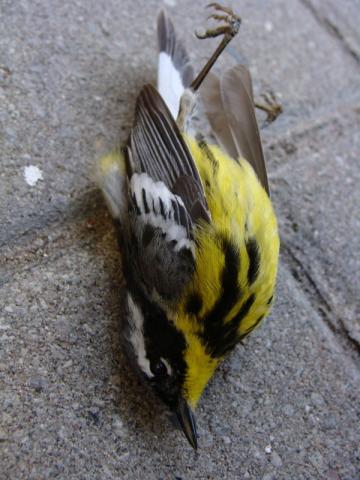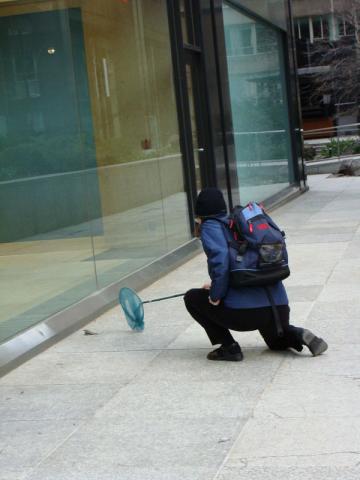
That’s certainly the case with the grisly urban phenomenon of migrating birds killed in collisions with windows in high-rise buildings. Across North America, the estimated number killed this way annually is a staggering 100 million to 1 billion.
An estimated one to 10 birds die per building per year primarily through spring and fall migration seasons. The City of Toronto has over 950,000 registered buildings that could potentially kill over nine million birds annually. Collisions with buildings are second only to habitat destruction as the leading human cause of bird death in North America.
By day, birds fly into windows they either cannot see or that reflect a landscape they mistake for their natural habitat. By night, windows disorient birds with reflective light. If the impact from a window crash doesn’t kill the bird, the plunge to the pavement below often does the job.
The keeper of all these sad statistics and many others is Michael Mesure, founder and executive director of Toronto’s Fatal Light Awareness Program — or FLAP — the first organization of its kind to advocate on behalf of birds colliding with buildings.
By its own admission, FLAP’s database of bird collision statistics is a primary resource for ornithological research worldwide; its data heavily cited in works concerned with the issue of bird-building collisions.
The non-profit FLAP also addresses the collision issue hands-on, with volunteers daily patrolling the bases of buildings deemed high risk to collect injured and dead birds.

While 40 percent of the injured birds rescued survive to be released back into the wild, the work performed by FLAP’s three full-time staff and volunteer corps of 60 is maddeningly preventable, and ceaselessly grim.
During the fall migration of 2005, for example, FLAP volunteers found approximately 3,400 birds in the select locations they patrolled. Of those, 2,100 were dead. The following March, FLAP — in partnership with the Royal Ontario Museum — laid out those multiple bird corpses in a gruesome collage, photographing them to raise awareness of the issue.
As the Toronto condo boom continues apace, Mesure and his dedicated flock are ramping up their efforts to help save millions of birds navigating the ages-old migration routes crucial to survival without smashing headlong into a shiny, reflective towers. Mesure took time out to speak with Samaritanmag about FLAP’s important work.
Samaritanmag: How did FLAP begin?
Michael Mesure: Around 1989, I happened to hear about how birds were flying into Toronto office towers at night and were being scooped up by building managers wanting to shield the public from the sight of dead birds on the ground in the morning. I didn’t believe it so I got myself up bright and early one morning and sure enough I was picking up birds. I found myself around town before daybreak more and more often.
Word got around about this guy downtown picking up birds, and people would come and find me to see if they could help. So by 1993, there was a small core group of us, and we decided to found FLAP. And we were definitely the first to do this. I looked around for examples of others doing similar work and couldn’t find any. I could not believe this was not on the radar. And it’s amazing how long it’s taken for this issue to get the attention it deserves.
Samaritanmag: Do people have lesser regard for birds than for, say, dogs or cats?
Michael Mesure: When people step outside their homes, one of the surest forms of wildlife they see is birds. It may be the only form of wildlife they see in an urban environment. And the birds they tend to see are more residential species – starlings, pigeons, sparrows. Those birds become part of the backdrop for most people. We come along and say, ‘Birds are colliding with buildings,’ and people say, ‘But I see birds everywhere.’ But the birds that we encounter aren’t the residential species; they are neo-tropical migrating species that are already experiencing significant population decline.
(Wide-ranging examples cited on FLAP’s list include at-risk species such as the Acadian Flycatcher, the Henslow's Sparrow and the Prothonotary Warbler not to mention the fabulously named Louisiana Waterthrush, the Yellow-bellied Flycatcher and Black-capped Chickadee.)
Michael Mesure: People don’t understand the diverse world of birds out there. There are over 450 species of birds that migrate through the Ontario region each and every year and the majority is vulnerable to strikes with buildings.
At yet, there is a fascination with – and this connection people have to – birds, which you can see in the many, many bird-feeders and birdhouses people keep on their property. So people just aren’t fully aware of how important it is for them to become a little more involved in the lives of birds. If we don’t deal with this, there won’t be many birds around for us to appreciate.

Michael Mesure: Roughly 30 to 35 percent of our annual funds come from individuals — just the average citizen who believes in what we do. About 55 to 60 percent of funding comes from grant foundations — government or private foundations that have environmental funds available to applicants like us. And then about 10 percent, if that, is corporate.
Samaritanmag: Is there a correlation between the small donations from corporations and tall buildings with reflective windows housing them?
Michael Mesure: Oh yes (laughs). Supporting our organization puts them into a position to acknowledge what they’re supporting. It’s a matter of practice what you preach. But corporations often focus on human initiatives like hospitals [that speak to] the very staff that work in those buildings.
Samaritanmag: We are detached from our environment.
Michael Mesure: Yes. A story I often tell proves that very point. There is one facility in this city that we monitor that has a significant collision problem. Our record at this location is over 500 bird collisions in a six-hour period. On one particular day, it was raining birds. You could just stand at the base of the building and catch them. There were picnic tables at the base of the structure where people were sitting having coffee breaks or on their lunch breaks and birds were dropping all around them; in some cases dropping into their lunches. People were shocked, disturbed, disgusted. So they would pick themselves up — and move to another table farther away to continue their lunch or their conversation.
There was no moment where people seemed to recognize that this shouldn’t be happening, that they went into the building to demand the owners and managers make it stop. As extreme an example as that might be, it reinforced the fact that people won’t get involved in these issues unless their lives are directly affected. They just won’t invest themselves in it.
Samaritanmag: So how difficult would it be to create buildings that would reduce or eliminate these collisions?
Michael Mesure: Easy. All a developer or architect has to do is place visual markers on glass that meet a certain criteria proven to alert birds to the presence of glass but that won’t interfere with our ability to see through that glass.
What’s difficult is creating urban structures that are acceptable to our eyes. The good news is that the City of Toronto now has standards in place for new construction, so all new construction must meet the bare minimum of requirements to make their glass visible to birds.

A company called Feather Friendly Technologies makes dots about an eighth of an inch in size. Placed about two-inches apart horizontally and vertically along the glass, you almost can’t see them but they make glass safe for birds. So it’s just a matter of adapting, and after a while it looks like an architectural feature.
This issue is easily resolved. It’s a matter of stepping away from what we’re comfortable with, putting our egos aside and dealing with it. Toronto is a leader in this regard and we’re proud of that. Eventually, when we find something that is at once appealing to people and visible to birds, it will transform how glass is manufactured.
Samaritanmag: Here’s hoping. The stats on bird deaths are just heartbreaking.
Michael Mesure: I know. But it’s not always about death. About 40 percent of the birds we find are alive and can be rehabilitated and released back into the wild. That helps us to keep going.
Women Nike cool nike high tops for boys boots women CK3172-002